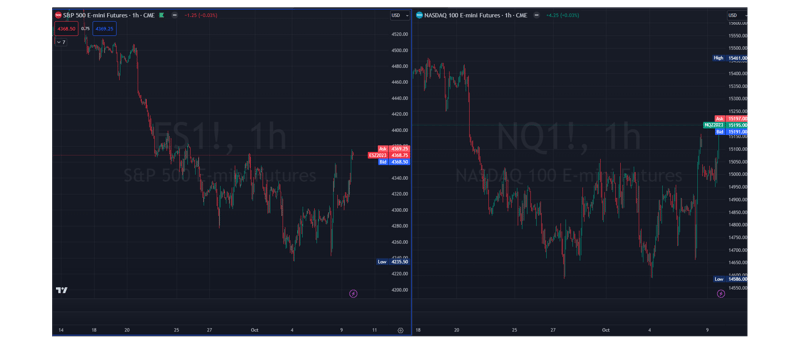Market Outlook 8th October 2023
Simplify the craziness
DAILY REVIEW
N
3 min read
The U.S. stock markets have found themselves grappling with the implications and potential risks associated with the ongoing Israel-Hamas conflict, highlighting the close relationship between geopolitical events and financial markets. This article delves into the repercussions of this extended conflict on U.S. stock futures and oil markets. Additionally, it explores the broader context of energy demand and the ongoing debate surrounding the concept of peak oil.
Market Reaction to Geopolitical Uncertainty
On Monday night, U.S. stock futures exhibited caution, hovering around stability levels. Dow Jones Industrial Average (DJIA) futures displayed a marginal decrease of 0.04%, while S&P 500 futures showed a slight dip of 0.03%. On the other hand, Nasdaq 100 futures experienced a modest increase of 0.02%.
Monday's trading session witnessed an initial decline, with the Nasdaq plummeting by over 1% at its lowest point. Nevertheless, a remarkable turnaround occurred, with the DJIA recording a gain of 197 points (0.59%), the Nasdaq Composite rising by 0.4%, and the S&P 500 advancing by 0.6%. This resilience of the U.S. equities market during geopolitical turmoil underscores its ability to weather uncertainty.
The Israel-Hamas Conflict
The Israel-Hamas conflict, marked by Hamas' deadliest offensive in five decades, has inflicted considerable human tolls on both sides. As of the latest available figures, over 900 Israelis have lost their lives in the conflict, while more than 687 Palestinians have perished in retaliatory Israeli airstrikes across the Gaza Strip. It's important to note that Hamas, designated as a terrorist organization and backed by Iran, has governed the Gaza Strip since 2007.
Market experts like Meera Pandit, the global market strategist at JPMorgan Asset Management, acknowledge that events of this nature can trigger market apprehensions. Nonetheless, historical trends suggest that the long-term market impact of such geopolitical events is generally contained. Market participants continue to monitor the situation closely.
Upcoming Economic Data
Amid geopolitical uncertainties, investors are closely monitoring forthcoming economic data releases. This includes the release of the NFIB Small Business Survey data for September and the figures for August's wholesale inventories. Additionally, the financial community will be attentive to PepsiCo's quarterly earnings results, as these can exert a notable influence on market sentiment.
Implications for the Oil Market
One immediate concern arising from the Israel-Hamas conflict is its potential impact on oil markets. Although neither Israel nor Palestine are major players in the global oil industry, the conflict unfolds within a strategically significant oil-producing region. Energy experts suggest that unless the conflict escalates substantially, the overall influence on oil markets is expected to remain constrained. Vandana Hari, CEO of Vanda Insights, anticipates a possible temporary surge in crude oil prices upon market opening, underscoring the need for continued monitoring.
The Southeast Asian Perspective
Beyond the Middle East, Southeast Asian nations are emerging as significant drivers of demand in the liquefied natural gas (LNG) market. Global LNG trade witnessed a record surge in 2022, largely attributed to increased European demand as an alternative to Russian pipelines following Russia's invasion of Ukraine. Industry experts, including Tony Regan from NexantECA, emphasize Southeast Asia, particularly countries such as Vietnam, Thailand, and Indonesia, as the focal point for the LNG market's growth.
Debating Peak Oil: OPEC vs. IEA
Amidst these geopolitical developments, the energy sector is witnessing a contentious debate regarding the concept of peak oil demand. OPEC (Organization of the Petroleum Exporting Countries) and the IEA (International Energy Agency) hold divergent viewpoints in their projections.
OPEC's 2023 World Oil Outlook foresees global oil demand reaching 116 million barrels per day (bpd) by 2045, reflecting an increase of 6 million bpd compared to the previous year's forecast. This optimistic projection starkly contrasts with the IEA's assertion that the world is entering the "beginning of the end" of the fossil fuel era. This disparity underscores the persistent uncertainty surrounding the energy sector's future trajectory.
Conclusion
The Israel-Hamas conflict serves as a vivid reminder of the intricate interplay between geopolitical events and financial markets. Initial market reactions, often characterized by anxiety and uncertainty, have historically stabilized over time. As market participants continue to closely monitor developments and upcoming economic data, the energy sector confronts its own challenges and debates, emphasizing the multifaceted nature of global financial markets. In light of these uncertainties, prudent investors are advised to remain vigilant, maintain diversified portfolios, and adapt to navigate the ever-evolving landscape of digital marketing and financial markets effectively.


